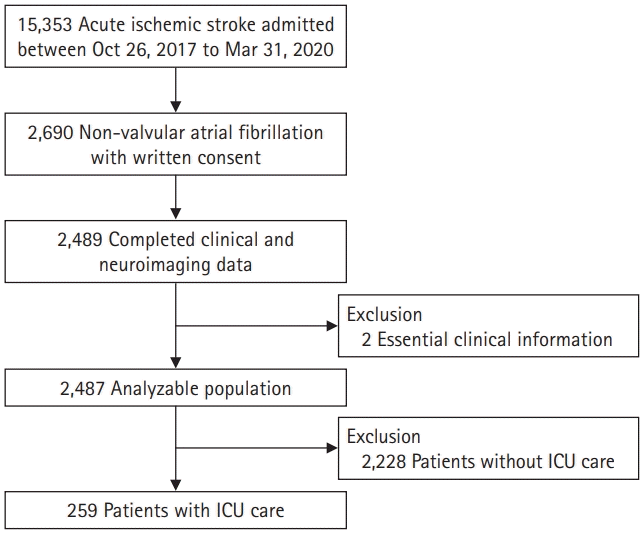INTRODUCTION
METHODS
Study subjects
Data collection and outcome assessment
Statistical analysis
RESULTS
Table 1.
| Variable | Value (n=259) |
|---|---|
| Sex | |
| Female | 128 (49.4) |
| Male | 131 (50.6) |
| Age (yr) | 78 (69–83) |
| Onset to arrival | 87.0 (43.5–290.5) |
| Vascular risk factor | |
| Hypertension | 182 (70.3) |
| Diabetes | 88 (34.0) |
| Dyslipidemia | 72 (27.8) |
| Current smoking | 36 (13.9) |
| History of stroke | 56 (21.6) |
| History of coronary heart disease | 42 (16.2) |
| Heart failure | 35 (13.5) |
| CHA2DS2-VASc score | 5.5±1.3 |
| Prior antithrombotics | 112 (43.2) |
| Premorbid mRS | 0 (0–1) |
| Stroke information | |
| Systolic BP (mmHg) | 151.3±27.9 |
| Diastolic BP (mmHg) | 87.7± 19.0 |
| Initial glucose (mg/dL) | 152.3±79.5 |
| Initial NIHSS score | 14 (8–19) |
| Symptomatic steno-occlusive lesion | 168 (64.9) |
| Emergent revascularization therapy | 139 (53.7) |
| Door to needle time (min)a) | 40.0 (27.0–53.0) |
| Door to punture time (min)b) | 107.0 (76.0–142.5) |
| Onset-to-reperfusion time (min)c) | 229.0 (187.5–295.0) |
| Antithrombotics within 48 hours | 210 (81.1) |
Values are presented as number (%), median (interquartile range), or mean±standard deviation.
mRS, modified Rankin scale; BP, blood pressure; NIHSS, National Institutes of Health Stroke Scale.
a) Defined in 89 patients who underwent intravenous thrombolysis and an onset-to-arrival of <24 hours;
Table 2.
| Outcome | Study population (n=259) |
|---|---|
| Discharge state | |
| In-hospital mortalitya) | 22 (8.5) |
| Transfer to other departments | 59 (22.8) |
| Discharge | 178 (68.7) |
| Early neurological deterioration | 44 (17.0) |
| Stroke recurrence | 6 (2.3) |
| Ischemic recurrence | 5 (1.9) |
| Hemorrhagic recurrence | 1 (0.4) |
| Stroke progression | 27 (10.4) |
| Brain swelling/IICP | 15 (5.8) |
| Symptomatic hemorrhagic transformation | 6 (2.3) |
| Others | 5 (1.9) |
| mRS at discharge | 4 (2–5) |
| Admission day | 15.4±19.0 |
| Discharge NIHSS score | 6 (2–16) |
| NIHSS score change | 3 (0–9) |
Table 3.
| Variable | In-hospital mortality (+) (n=22) | In-hospital mortality (–) (n=237) | P-value |
|---|---|---|---|
| Sex | 0.163a) | ||
| Female | 14 (63.6) | 114 (48.1) | |
| Male | 8 (36.4) | 123 (51.9) | |
| Age (yr) | 81 (76–86) | 78 (68–83) | 0.029f) |
| Onset to arrival | 101.0 (41.0–391.0) | 87.0 (44.0–277.0) | 0.810 |
| Vascular risk factor | |||
| Hypertension | 13 (59.1) | 169 (71.3) | 0.230a) |
| Diabetes | 11 (50.0) | 77 (32.5) | 0.097a) |
| Dyslipidemia | 4 (18.2) | 68 (28.7) | 0.455b) |
| Current smoking | 3 (13.6) | 33 (13.9) | 1.000b) |
| History of stroke | 4 (18.2) | 52 (21.9) | 0.793b) |
| History of coronary heart disease | 6 (27.3) | 36 (15.2) | 0.141a) |
| Heart failure | 1 (4.5) | 34 (14.3) | 0.328b) |
| CHA2DS2-VASc score | 6.1±1.3 | 5.4±1.3 | 0.022 |
| Prior antithrombotics | 9 (47.4) | 103 (42.9) | 0.706b) |
| Premorbid mRS | 0 (0–2) | 0 (0–1) | 0.125 |
| Stroke information | |||
| Systolic BP (mmHg) | 155.5±29.8 | 150.9±27.8 | 0.462 |
| Diastolic BP (mmHg) | 95.8±29.2 | 86.9±17.7 | 0.175 |
| Initial glucose (mg/dL) | 170.5±62.0 | 150.6±80.8 | 0.264 |
| Initial NIHSS score | 19 (14–24) | 14 (7–18) | 0.002f) |
| Symptomatic steno-occlusive lesion | 19 (86.4) | 149 (62.9) | 0.027a),f) |
| Emergent revascularization therapy | 10 (45.5) | 129 (54.4) | 0.419a) |
| Door to needle time (min)c) | 37.0 (35.0–45.5) | 40.5 (26.0–53.0) | 0.790 |
| Door to punture time (min)d) | 108.0 (92.0–160.0) | 107.0 (75.0–142.0) | 0.484 |
| Onset to reperfusion time (min)e) | 367.0 (269.5–423.0) | 226.0 (184.0–285.0) | 0.164 |
| Antithrombotics within 48 hours | 11 (50.0) | 199 (84.0) | <0.001a),f) |
Values are presented as number (%), median (interquartile range), or mean±standard deviation.
mRS, modified Rankin scale; BP, blood pressure; NIHSS, National Institutes of Health Stroke Scale.
c) Defined in 89 patients who underwent intravenous thrombolysis and an onset-to-arrival of <24 hours;
d) Defined in 99 patients who underwent endovascular treatment and an onset-to-arrival of <24 hours;




 PDF
PDF Citation
Citation Print
Print




 XML Download
XML Download